The 2024 season is upon us which means it’s almost time to see how programs slot their incoming freshmen into lineups. That being said, there’s still plenty of time for fans to speculate and make predictions. Since the inaugural release of the College Gym News recruit ratings system, there have been two classes of recruits that have finished their freshmen seasons. We wanted to know: how have CGN-rated athletes performed during their freshman year? In other words, does our rating system accurately predict performance?
To complete this analysis, we used data from freshmen who competed in the 2022 and 2023 seasons. Over the past two seasons, there were 965 first-year athletes added to rosters throughout the various divisions of college gymnastics. While rated recruits tend to generate the most buzz, only about a quarter (22.5%) of the freshmen were rated. The remaining athletes (77.5%) all entered college unrated.
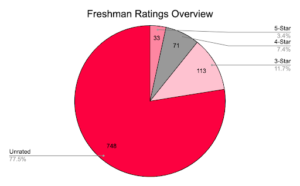
Being on a college roster at any level and with any rating is a success in itself, but the level of contribution is what truly sets exceptional athletes apart from their peers. According to the data, the majority (66.94%) of freshmen contributed at least one routine during their freshman season, while the remaining athletes didn’t see any lineup time. Four-star recruits saw the highest contribution level, with 83.10% of them competing at least one routine, followed closely by 5-star recruits (81.82%) and 3-star recruits (73.45%). Unrated recruits finished slightly below the overall average, at 63.77% of athletes contributing to lineups.

Despite a smaller percentage of athletes seeing lineup time, unrated recruits still contributed over 50% of all routines competed by freshmen over the last two seasons due to the sheer number of unrated recruits as compared to rated recruits.
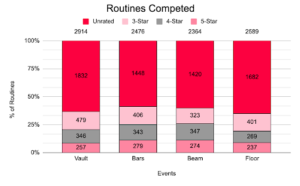 When you look at the total number of routines that are competed throughout a season and divide that by the number of athletes, a freshman contributes, on average, 10.70 total routines during the season. Five-star recruits contribute a considerably above-average number of routines, at 31.73 throughout the season. Four-star and 3-star recruits followed by contributing 18.38 and 14.24 routines respectively, while unrated recruits contributed 8.51 routines.
When you look at the total number of routines that are competed throughout a season and divide that by the number of athletes, a freshman contributes, on average, 10.70 total routines during the season. Five-star recruits contribute a considerably above-average number of routines, at 31.73 throughout the season. Four-star and 3-star recruits followed by contributing 18.38 and 14.24 routines respectively, while unrated recruits contributed 8.51 routines.
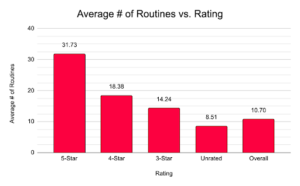
The CGN data team also averaged the number of events on which an athlete competed at least one routine as well as the number of events on which an athlete earned an NQS. We found that five-star recruits tend to compete in a higher number of events while unrated recruits are more likely to be specialists. Additionally, five-star recruits have the least difference between the two metrics, showing that when they compete on an event they are more likely to be a steady lineup contributor versus being a depth option that competes every so often but not enough to earn an NQS.

We also looked at the number of times an athlete competed as compared to how many opportunities they had. On average, 5-star athletes were in the lineup 58.15% of the time. While athletes rated four stars and below appeared in the lineup considerably less often.
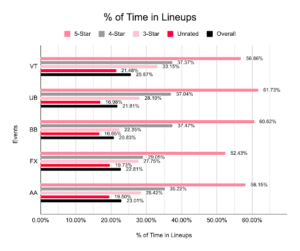
Quantity isn’t the only factor when determining an athlete’s level of contribution. In college gymnastics, quality is arguably an even better indicator. To determine the quality of each athlete’s gymnastics, we averaged event–high scores by each rating as well as among all freshmen. Every high score, regardless of the event, was also averaged by rating and overall among all freshmen. This left us with data for each group of rated athletes as well as the incoming class as a whole. Among all freshmen on every event, the average high score was 9.634. Five-star recruits far outpaced this metric with an average high of 9.921, a number that held relatively steady across all four events. Interestingly, bars saw the highest average high of 9.938 for 5-star recruits, but also the lowest average high of 9.442 for unrated recruits. On floor, four-star recruits and three-star recruits had very similar average highs of 9.840 and 9.835 respectively, the smallest difference on any event. Overall, the data shakes out much like one would expect with five-star athletes scoring the highest across the board, followed by four-star and three-star athletes. Rated recruits consistently scored above the overall average high, while unrated recruits finished below.
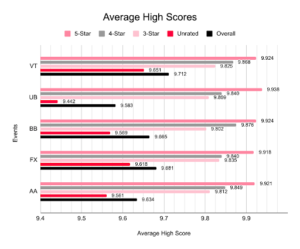
While scoring potential is certainly important, having the ability to maintain a high average throughout the season says a lot about both an athlete’s consistency and their ability to hit. Weighted averages were calculated for the same groups as above. Since an athlete’s average on each event can be made up of anywhere from one to 16 routines, each athlete’s average score was weighted based on the number of times they competed throughout their freshman season. Once again, the data reads as expected following the same trend that was seen above with high scores. Bars was once again the lowest–scoring event with a weighted average of 9.183 for unrated recruits. Floor had the highest weighted average for five-star freshmen at 9.866. The smallest difference in scoring between groups once again includes four-star and three-star athletes. Across all events, there was only a 0.025 difference in weighted average between them.

Similar trends also appear when looking at average NQS. Once again, bars had the lowest average NQS at 9.411 for unrated athletes while floor had the highest average at 9.899 for five-star athletes. The smallest difference in average NQS between groups (0.020) comes once again on floor, but this time between five-star and four-star athletes.
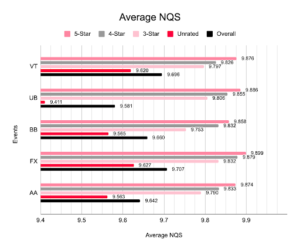
In conclusion, five-star freshmen are undeniably the highest–performing athletes in their class. They lead their peers by almost every metric and are certainly the top picks for coaches and fantasy gymnastics players alike. However, with only 3.4% of recent freshmen earning a five-star rating, there’s not a lot of them to go around. The majority of college routines come from other athletes, rated or not. While they may not have the scoring potential of five-star athletes, the majority of freshmen do see at least some lineup time. It should also be noted that CGN rates athletes in the all–around, meaning that someone who stands out on a singular event may be rated lower, or go unrated completely, although they have a particular event that they are sure to be a lineup mainstay on in college. Some athletes also don’t get rated due to a lack of available video or come into college underrated because they had a stellar senior season that wasn’t factored into their rating. There’s no perfect way to predict freshman performance because there are so many factors to consider. However, using recruit ratings provides coaches and fans with a solid starting-off point and highlights some notable trends.
READ THIS NEXT: 2024 Freshman Class Rankings
Article by Mariah Dawson

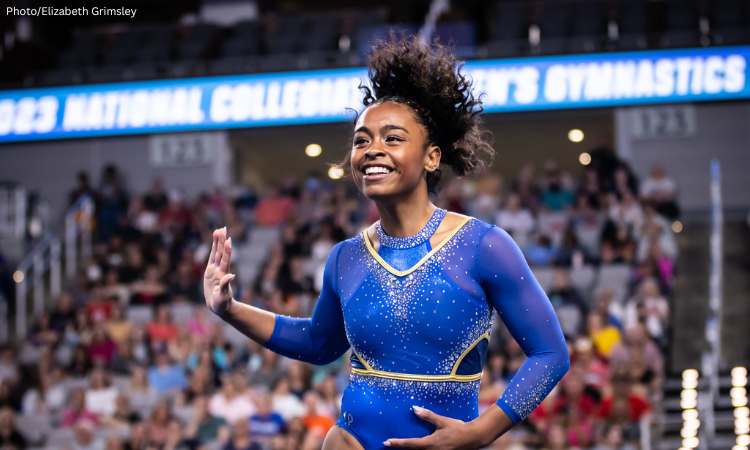

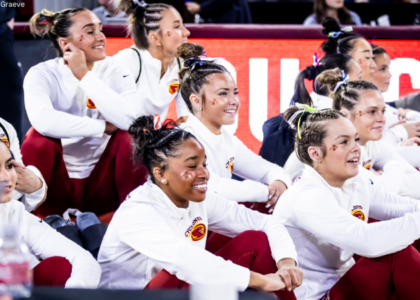
When will you update the 2024-2025 rankings again?